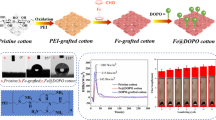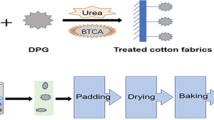Abstract
This research focused on preparing antibacterial and flame-retardant multifunctional cotton fabric to decrease the threat of harmful microorganism and fire, which might have huge potential application in household textiles. A water-soluble N-halamine precursor based on s-triazine (TIAPC) was synthesized by introducing iminodiacetic acid (IDA), which can chelate with metal ions to obtain flame retardancy. After coating with TIAPC, the cotton fabric was chlorinated in dilute bleach solution and chelated in metal salt solution to achieve antibacterial and flame-retardant properties. The surface morphology and chemical state of TIAPC-coated cotton fabric were characterized by FT-IR, XPS, SEM and EDX. The chlorinated TIAPC-coated cotton fabric displayed high-efficacy and rapid bactericidal effect against S. aureus and E. coli O157: H7 with 100% bacterial reduction in 1 min. Meanwhile, the chelated TIAPC-modified cotton fabric presented good thermal stability and char-forming capability. The hydrophobic property of modified cotton fabric was greatly improved after chlorination. Besides, this multifunctional coating had little effect on the cytotoxicity, tensile strength, air permeability, whiteness and drape of cotton fabric.
Graphic abstract








Similar content being viewed by others
References
Acikel SM, Senay RH, Akgol S, Aslan A (2017) Removal of acid black 210 dye from leather dyeing effluent using spherical particles of P(HEMA-GMA)IDA-Cr(III) hydrogel membrane. J Soc Leather Technol Chem 101:135–142
Ahmed AI, Hay JN, Bushell ME, Wardell JN, Cavalli G (2009) Optimizing halogenation conditions of N-halamine polymers and investigating mode of bactericidal action. J Appl Polym Sci 113:2404–2412
Bai R, Zhang Q, Li L, Li P, Wang YJ, Simalou O, Dong A (2016) N-Halamine-Containing electrospun fibers kill bacteria via a contact/release co-determined antibacterial pathway. ACS Appl Mater Int 8:31530–31540
Cerkez I, Kocer HB, Worley SD, Broughton RM, Huang TS (2012) N-halamine copolymers for biocidal coatings. React Funct Polym 72:673–679
Chen H, Li Q, Wang M, Ji D, Tan W (2020a) XPS and two-dimensional FTIR correlation analysis on the binding characteristics of humic acid onto kaolinite surface. Sci Total Environ 724:138154
Chen W, Zhu Y, Zhang Z, Gao Y, Liu W, Borjihan Q, Dong A (2020b) Engineering a multifunctional N-halamine-based antibacterial hydrogel using a super-convenient strategy for infected skin defect therapy. Chem Eng J 379:122238
Demir B, Broughton RM, Qiao M, Huang TS, Worley SD (2017) N-halamine biocidal materials with superior antimicrobial efficacies for wound dressings. Molecules 22(10):1582
El-Nahhal IM, Zaggout FR, Nassar MA, El-Ashgar NM, Maquet J, Babonneau F, Chehimi MM (2003) Synthesis, characterization and applications of immobilized iminodiacetic acid-modified silica. J Sol-Gel Sci Technol 28(2):255–265
Hanshaw RG, Stahelin RV, Smith BD (2008) Noncovalent keystone interactions controlling biomembrane structure. Chem-Eur J 14(6):1690–1697
Hisaki I, Sasaki T, Tohnai N, Miyata M (2012) Supramolecular-tilt-chirality on twofold helical assemblies. Chem-Eur J 18(33):10066–10073
Huang Y, Zhu Q, Sheng T, Hu S, Fu R, Shen C, Wu X (2013) Lanthanide coordination polymers assembled from triazine-based flexible polycarboxylate ligands and their luminescent properties. CrystEngComm 15(18):3560–3567
Jahangiri A, Ghoreishian SM, Akbari A, Norouzi M, Ghasemi M, Ghoreishian M, Shafiabadi E (2018) Natural dyeing of wool by madder (Rubia tinctorum L.) root extract using tannin-based biomordants: colorimetric, fastness and tensile assay. Fiber Polym 19(10):2139–2184
Jiang Z, Ma K, Du J, Li R, Ren X, Huang TS (2014) Synthesis of novel reactive N-halamine precursors and application in antimicrobial cellulose. Appl Surf Sci 288:518–523
Kagarise RE (1955) Spectroscopic studies on the soaps of phenylstearic acid. I. Infrared absorption spectra and the hydrolysis of soap films. J Phys Chem 59(3):196–205
Kang ZZ, Zhang B, Jiao YC, Xu YH, He QZ, Liang J (2013) High-efficacy antimicrobial cellulose grafted by a novel quaternarized N-halamine. Cellulose 20(2):885–893
Kocer HB, Cerkez I, Worley SD, Broughton RM, Huang TS (2011) Polymeric antimicrobial N-halamine epoxides. ACS Appl Mater Inter 3(8):2845–2850
Lai X, Zeng X, Li H, Liao F, Yin C, Zhang H (2012) Synergistic effect between a triazine-based macromolecule and melamine pyrophosphate in flame retardant polypropylene. Polym Compos 33(1):35–43
Li S, Lin X, Liu Y, Li R, Ren X, Huang TS (2019) Phosphorus-nitrogen-silicon-based assembly multilayer coating for the preparation of flame retardant and antimicrobial cotton fabric. Cellulose 26(6):4213–4223
Ma K, Liu Y, Xie Z, Li R, Jiang Z, Ren X, Huang TS (2013) Synthesis of novel N-halamine epoxide based on cyanuric acid and its application for antimicrobial finishing. Ind Eng Chem Res 52(22):7413–7418
Mazik M, Cavga H (2006) Carboxylate-based receptors for the recognition of carbohydrates in organic and aqueous media. J Organ Chem 71(8):2957–2963
Mu T, Pan N, Wang Y, Ren X, Huang TS (2018) Antibacterial coating of cellulose by Iso-bifunctional reactive N-halamine with the dyeing process of reactive dye. Fiber Polym 19(11):2284–2289
Omer AM, Elgarhy GS, El-Subruiti GM, Khalifa RE, Eltaweil AS (2020) Fabrication of novel iminodiacetic acid-functionalized carboxymethyl cellulose microbeads for efficient removal of cationic crystal violet dye from aqueous solutions. Int J Biol Macromol 148:1072–1083
Pan Y, Wang W, Liu L, Ge H, Song L, Hu Y (2017) Influences of metal ions crosslinked alginate based coatings on thermal stability and fire resistance of cotton fabrics. Carbohydr Polym 170:133–139
Razak MR, Yusof NA, Haron MJ, Ibrahim N, Mohammad F, Kamaruzaman S, Al-Lohedan HA (2018) Iminodiacetic acid modified kenaf fiber for waste water treatment. Int J Biol Macromol 112:754–760
Ren X, Kou L, Liang J, Worley SD, Tzou YM, Huang TS (2008) Antimicrobial efficacy and light stability of N-halamine siloxanes bound to cotton. Cellulose 15(4):593–598
Ren X, Kou L, Kocer HB, Worley SD, Broughton RM, Tzou YM, Huang TS (2009) Antimicrobial modification of polyester by admicellar polymerization. J Biomed Mater Res B 89(2):475–480
Richards GN, Zheng G (1991) Influence of metal ions and of salts on products from pyrolysis of wood: applications to thermochemical processing of newsprint and biomass. J Anal Appl Pyrol 21(1–2):133–146
Shi R, Tan L, Zong L, Ji Q, Li X, Zhang K, Xia Y (2017) Influence of Na+ and Ca2+ on flame retardancy, thermal degradation, and pyrolysis behavior of cellulose fibers. Carbohydr Polym 157:1594–1603
Sosa GL, Zalts A, Ramirez SA (2016) Complexing capacity of electroplating rinsing baths-a twist to the resolution of two ligand families of similar strength. J Anal Sci Technol. https://doi.org/10.1186/s40543-016-0088-3
Sun G, Xu XJ, Bickett JR, Williams JF (2001) Durable and regenerable antibacterial finishing of fabrics with a new hydantoin derivative. Ind Eng Chem Res 40(4):1016–1021
Sun Y, Sun G (2002) Durable and regenerable antimicrobial textile materials prepared by a continuous grafting process. J Appl Polym Sci 84(8):1592–1599
Tian H, Zhai Y, Xu C, Liang J (2017) Durable antibacterial cotton fabrics containing stable acyclic N-halamine groups. Ind Eng Chem Res 56(28):7902–7909
Viola MN, Ikram M, Rehman S, Ali S, Akhtar MN, Aidamen MA, Schulzke C (2019) A paddle wheel dinuclear Copper(II) carboxylate: crystal structure, thermokinetic and magnetic properties. J Mol Struct 1196:754–759
Wang X, Xu M, Zhang Z, Leng Y, Li B (2018) Synthesis of a novel N-alkoxyamine containing compound and its application as an effective flame retardant for polypropylene film by quenching free radical. J Anal Appl Pyrol 134:243–253
Wen W, Zhang Z, Jing L, Zhang T (2020) Synthesis of a Hein-Schiff base compound and its antibacterial activity on cotton fabrics. Cellulose 27(12):7243–7254
Worley SD, Chen Y, Wang JW, Wu R (2005) Novel N-halamine siloxane monomers and polymers for preparing biocidal coatings. Surf Coat Int B 88(2):93–99
Xu D, Ma X, Zhu P, Jiang Z (2020) A novel durable and water-soluble N-halamine precursor for antibacterial cellulose fabrics. AATCC J Res 7(3):34–41
Yin M, Wang Y, Zhang Y, Ren X, Qiu Y, Huang TS (2020) Novel quaternarized N-halamine chitosan and polyvinyl alcohol nanofibrous membranes as hemostatic materials with excellent antibacterial properties. Carbohydr Polym 232:115823
Zhang B, Jiao Y, Kang Z, Ma K, Ren X, Liang J (2013) Durable antimicrobial cotton fabrics containing stable quaternarized N-halamine groups. Cellulose 20(6):3067–3077
Zhang K, Zong L, Tan Y, Ji Q, Yun W, Shi R, Xia Y (2016) Improve the flame retardancy of cellulose fibers by grafting zinc ion. Carbohydr Polym 136:121–127
Zhang Y, Zhu L, Wang Y, Lou Z, Shan W, Xiong Y, Fan Y (2018) Preparation of a biomass adsorbent for gallium(III) based on corn stalk modified by iminodiacetic acid. J Taiwan Inst Chem E 91:291–298
Zhang S, Demir B, Ren X, Worley SD, Broughton RM, Huang TS (2019) Synthesis of antibacterial N-halamine acryl acid copolymers and their application onto cotton. Appl Polym Sci 136(16):47426
Zhou X, Zhou J, Liu Y, Guo J, Ren J, Zhou F (2018) Preparation of iminodiacetic acid-modified magnetic biochar by carbonization, magnetization and functional modification for Cd(II) removal in water. Fuel 233:469–479
Zhu FL, Li X, Feng QQ (2020) Thermal decomposed behavior and kinetic study for untreated and flame retardant treated regenerated cellulose fibers using thermogravimetric analysis. J Therm Anal Calorim. https://doi.org/10.1007/s10973-020-09780-y
Acknowledgments
The authors would like to thank the National Natural Science Foundation of China (51703101, 51991354).
Author information
Authors and Affiliations
Corresponding authors
Ethics declarations
Conflict of interest
The authors declare that they have no known competing financial interests or personal relationships that could have appeared to influence the work reported in this paper.
Ethical approval
This article does not contain any studies with human participants or animals performed by any of the authors.
Additional information
Publisher's Note
Springer Nature remains neutral with regard to jurisdictional claims in published maps and institutional affiliations.
Supplementary Information
Below is the link to the electronic supplementary material.
Rights and permissions
About this article
Cite this article
Xu, D., Wang, S., Hu, J. et al. Enhancing antibacterial and flame-retardant performance of cotton fabric with an iminodiacetic acid-containing N-halamine. Cellulose 28, 3265–3277 (2021). https://doi.org/10.1007/s10570-021-03716-x
Received:
Accepted:
Published:
Issue Date:
DOI: https://doi.org/10.1007/s10570-021-03716-x




